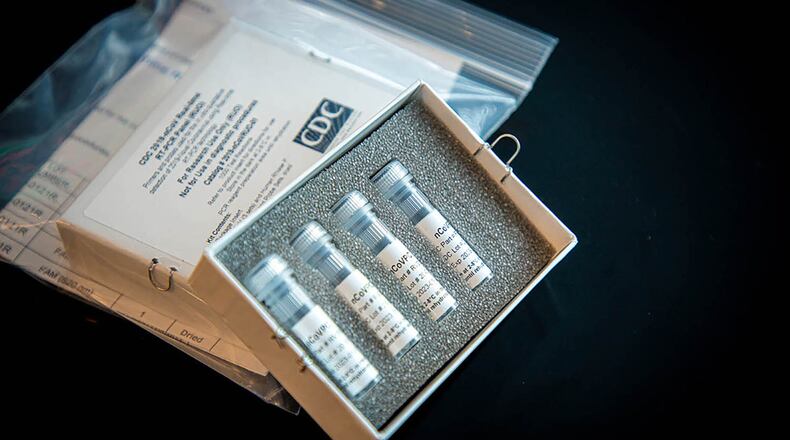“It depends a lot on local initiatives, as there is not yet a clear state plan to ensure universal testing occurs in congregate settings with positive cases or, ideally, in all congregate settings (as already occurred in some prisons),” Pete Van Runkle, executive director of Ohio Health Care Association, which represents nursing homes, said in an email.
Van Runkle said access to testing is improving with the new guidelines the state issued last week “but it is still spotty.” Last week, the Ohio Department of Health updated its guidelines on who is a testing priority to also include long-term care staff and residents who were exposed to COVID-19 but don’t have symptoms.
PREVIOUS COVERAGE: Experts say nursing home cases a sign of how infectious coronavirus is
While an outsized number of Ohioans who died from the outbreak have been older adults in these living communities, operators have struggled to get higher levels of testing. This makes infection control difficult, particularly when people with no symptoms can bring the virus in, and a mask and gown shortage exacerbates the inability to keep the coronavirus out.
LeadingAge Ohio, which represents nonprofit long-term care providers, is hopeful a testing program in central Ohio can take off statewide.
The testing effort is the Post-Acute Regional Rapid Testing program launched earlier in April in central Ohio where a swab team, trained and in full personal protective gear, offers testing within 24 hours of symptoms arising, collects swabbed specimens at each site, and delivers them to the Ohio Department of Health for results in a day. This also means contact tracing to determine additional testing needs and precautionary measures such as quarantine.
Coronavirus: Complete coverage from the Dayton Daily News
“For most individuals, the normal path to testing is a visit to a primary care physician followed by a visit to a testing site,” National Church Residences Chief Medical Officer John Weigand said. “This is impractical for at-risk seniors and we want to provide a more direct route to testing for our residents in skilled nursing and assisted living communities.”
LeadingAge Ohio President Kathryn Brod said a localized approach that provides older adults with testing in their homes, including nursing homes and assisted living, is necessary.
Senior living facilities still have to navigate a muddled and expensive market for medical masks, gowns and gloves. Some nursing home groups didn’t have existing connections to personal protective gear suppliers and are now struggling to secure a supply in a hectic market where others have existing relationships, said Van Runkle. There’s been some nontraditional sources of supply, donations and government efforts, but he said the challenge remains.
“The distributors are in a position where they are limiting their sales to existing customers and they are limiting to only a percentage of what they were able to get pre-COVID. Of course, pre-COVID you were using a lot less, so you really need more, not less,” Van Runkle said.
MORE: How disease detectives work to trace and block virus path
MORE: ‘Complex’ supply issues hamper widespread testing roll out
Other expenses are also up. There are extra labor and supply costs to measures for keeping residents separate and safe, with Van Runkle giving an example of staff working in special COVID-19 units being paid extra. Over a month into visitor restrictions, Ohio came out with a grant for helping providers to buy iPads or video chat tech so residents can connect with love ones, Van Runkle said.
The American Health Care Association, the national affiliate of Ohio Health Care Association, sent out a recommendation to nursing homes suggesting that members who don’t have enough PPE or staff document their requests for help “to show, if challenged later, that the provider did everything possible to obtain needed resources to deliver care but could not do so.”
On Ohio preparing to reopen, Brod, with LeadingAge, said Ohio now has the critical pieces in place to make sure communities can manage COVID-19 in congregate settings.
“Testing is coming online, supply chains for PPE are beginning to move, and we have promising models in which collaboration between hospitals, long-term care, and local health departments are taking shape,” Brod said. “We remain concerned that these pieces have not yet become a cohesive, high-functioning response system. We are hopeful that over the coming days and weeks, there will be increased collaboration and partnership across all Ohio communities.”
Take survey on Ohio assisted living, nursing homes
For families of nursing home and assisted living residents, how are you keeping in touch with your family member during this time? Researchers at the Scripps Gerontology Center at Miami University want to hear from you to learn more about how love ones are communicating. Their survey takes five to 10 minutes and can be found at bit.ly/Scripps-COVID19-LTCFamilySurvey.
Jane Straker, director of research at Scripps, said the goal is to learn what facilities are doing and how families are feeling about how things are going, and then create a quick report that can be shared with the public and providers.
Straker also hopes to pick up on innovations and ideas that can be shared, based on stories from families.
About the Author
